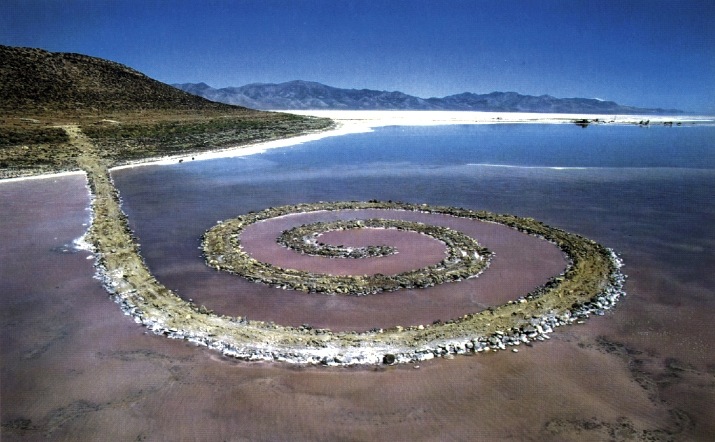The term conceptual art came into use in the late 1960s to describe artwork in which the concept (idea) behind the artwork is more important than traditional aesthetic and materials concerns (what it looks like or how it is made).
Conceptual artists do not set out to make a painting or a sculpture and then fit their ideas to that existing from. Instead they think beyond the limits of those traditional media, and then work out their concept or idea in any materials and whatever form is appropriate.
Land Art
Land art was usually documented in artworks using photographs and maps which the artists could exhibit in galleries. Land artists also made land art in galleries by bringing in materials from the landscape and using it to create their piece.
Robert Smithson
He was an American artist famous for his use in photography in relation to sculpture and land art. His earliest pieces were paintings and collages, but he soon came to focus on sculpture; he responded to the Minimalism and Conceptualism of the early 1960s and he started to expand his work out of galleries and into the landscape. In 1970, he produced the Earthwork, or Land art, for which he is best known, 'Spiral Jetty', a remarkable coil of rock composed in the colored waters of the shore of the Great Salt Lake in Utah.
Andrew Goldsworthy
is a British sculptor, photographer and environmentalist producing site-specific sculpture and land art situated in natural and urban settings, and collaborates with nature to make his creations. His creations are transient, or ephemeral. He photographs each piece once right after he makes it. His goal is to understand nature by directly participating in nature as intimately as he can. He generally works with whatever comes to hand: twigs, leaves, stones, snow and ice, reeds and thorns.
Richard Long
He is an English sculptor and one of the best known British land artists.
Long is the only artist to have been short-listed four times for the Turner Prize. He was nominated in 1984, 1987 and 1988, and then won the award in 1989 for White Water Line. Within a year of his departure from St Martin's, Long was closely associated with the emergence of a new art form, Land art, having already produced such works as 'A Line Made by Walking' this is made by a trail left in the grass by walking back and forth in a straight line.

Performance
Its origins began in 'Dada' and 'Futurism' with Salvador Dali and Marcel Duchamp. Its influence later inspired the likes of Jackson Pollock and the 'abstract expressionists'. It later goes on to inform 'Actionism' and digital artists such as Stelarc and Bruce Nauman.
Photography and Film
Most artist documented the conceptual practice as an artifact to the event using the new form of art photography. This later in the 60s moves onto film and now into a digital world.
Arte Povera
Translated to 'poor art'. It was a move away from traditional materials such as oil paints, bronze and plaster and move towards no conventional materials such as everyday liquids, soil, rags, redundant objects. Basically anything you can find that no longer has its original purpose.
Found Object
A found object is natural or man made ( or fragment of an object) found ( or sometimes bought) by an artist and kept because of some intrinsic interest the artist sees in it.

No comments:
Post a Comment